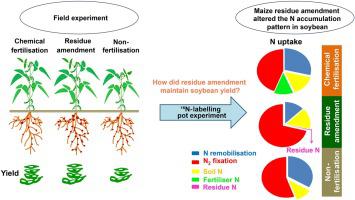Field Crops Research ( IF 5.8 ) Pub Date : 2021-08-30 , DOI: 10.1016/j.fcr.2021.108269 Zhihuang Xie 1, 2 , Yansheng Li 1 , Zhenhua Yu 1 , Guanghua Wang 1 , Caixian Tang 3 , Ulrike Mathesius 4 , Xiaobing Liu 1 , Junjie Liu 1 , Judong Liu 1 , Stephen J. Herbert 5 , Junjiang Wu 6 , Jian Jin 1, 3

|
Crop residue amendment to soil is recommended as an effective management practice to return nutrients, especially in the maize-soybean rotation system where large amounts of maize residues are produced. Quantifying the utilisation of maize-residue N by the subsequent soybean crop is essential for optimising the N fertilisation strategy for sustainable production. However, whether and how maize residue amendment alters N acquisition in soybean plants are largely unknown. It was hypothesised that maize residue would supply N and enhance N2 fixation to meet the N requirements of subsequent soybeans. Three treatments, namely: 1) chemical fertiliser (55.2, 35.2 and 22.4 kg ha−1 of N, P and K, respectively), 2) maize residue (8 t ha−1), and 3) non-fertiliser were applied in a maize-soybean rotation system in a Mollisol soil. It was demonstrated that soybean seed yield in the maize-residue treatment was the same as that in the chemical fertiliser treatment, with 2.9 vs. 3.2 t ha−1 in 2014, 2.7 vs. 2.6 t ha−1 in 2016, and 3.0 vs. 3.1 t ha−1 in 2018. A follow-up pot experiment using 15N-labelled residue indicated that the residue-derived N accounted for 0.5 % of the total N in soybean seeds and the proportion of symbiotically fixed N reached 82 %. The amount of fixed N during the pod-filling period in the residue treatment was 0.66 g plant-1, which was 49 % and 41 % higher than those in the chemical fertiliser and non-fertiliser treatments, respectively. The stimulation of N2 fixation was associated with an increase in fixed N per nodule and the enrichment of diazotrophs in the rhizosphere of soybean. With maize residue amendment, the increased N2-fixing capability of nodules during the reproductive period, rather than residue-derived N, fulfilled the N demand for maintaining seed yield of soybean. In the maize-soybean rotation system, maize residue amendment would facilitate the N2 fixation to partly substitute for N fertiliser for soybean production in Mollisols.
中文翻译:

在 Mollisol 中掺入玉米作物残留物通过刺激固氮而不是残留物衍生的氮来维持大豆产量
建议对土壤进行作物残留改良作为一种有效的管理措施,以恢复养分,特别是在产生大量玉米残留的玉米-大豆轮作系统中。量化后续大豆作物对玉米残留氮的利用对于优化可持续生产的施氮策略至关重要。然而,玉米残留改良剂是否以及如何改变大豆植物中氮的获取在很大程度上是未知的。假设玉米渣将供应N 并增强N 2固定以满足后续大豆的N 需求。三个处理,即:1)化肥(氮、磷、钾分别为55.2、35.2 和 22.4 kg ha -1),2)玉米秸秆(8 t ha -1) 和 3) 在 Mollisol 土壤中的玉米-大豆轮作系统中施用非肥料。结果表明,玉米渣处理的大豆种子产量与化肥处理相同,2014 年分别为 2.9 比 3.2 t ha -1,2016年分别为 2.7 比 2.6 t ha -1和 3.0 比3.2 t ha -1。. 3.1 t ha -1 in 2018. 使用15 N标记残留物的后续盆栽试验表明,残留物衍生的N占大豆种子中总N的0.5%,共生固定N的比例达到82%。残渣处理结荚期固定氮量为0.66 g植株-1,分别比化肥和不施肥处理高 49% 和 41%。N 2固定的刺激与每个根瘤固定N的增加和大豆根际固氮菌的富集有关。随着玉米渣修正案中,增加的Ñ 2在生殖周期结节-定影能力,而不是残留物衍生的N,满足用于维持大豆的种子产量的N个需求。在玉米-大豆旋转系统,玉米渣修正案将有助于Ñ 2固定到部分地代替氮肥对大豆产量黑土。



























 京公网安备 11010802027423号
京公网安备 11010802027423号